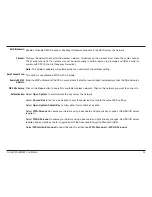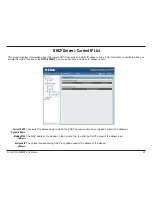
D-Link DWL-8200AP User Manual
Super Mode
without Turbo:
Super Mode
with Static
Turbo:
Super Mode
with Dynamic
Turbo:
WMM:
Capable of Packet Bursting, FastFrames, Compression, and no Turbo mode.
Capable of Packet Bursting, FastFrames, Compression, and Static Turbo. This setting is not backwards
compatible with non-Turbo (legacy) devices. Static turbo mode is always on and is only enabled when all
the devices on the wireless network are configured with Super Mode with Static Turbo enabled.
Note:
Super Mode with Static Turbo is only available for 802.11a.
Capable of Packet Bursting, FastFrames, Compression, and Dynamic Turbo. This setting is backwards
compatible with non-Turbo (legacy) devices. Dynamic Turbo Mode is only enabled when all
devices on the wireless network are configured with Super Mode with Dynamic Turbo enabled.
(Wi-Fi Multimedia) Improves the user experience for audio, video, and voice applications over a Wi-Fi network. WMM
is based on a subset of the IEEE 802.11e WLAN QoS standard.
Antenna
Diversity:
Data Rate
Control:
The Preamble Type defines the length of the CRC (Cyclic Redundancy Check) block for communication between the
Access Point and roaming wireless adapters. The default setting is set to “Short and long” Preamble.
Note:
High network traffic areas should use the shorter preamble type. CRC is a common technique for detecting
data transmission errors.
Preamble
(802.11g only):
This function allows you to configure the wireless network with IEEE 802.11g only, IEEE 802.11b only, or IEEE
802.11g with backward interoperability with IEEE 802.11.
Wireless B/G
Mode
(802.11g only):
This option is enabled by default. When enabled, each radio (5GHz/2.4GHz) will automatically switch to the antenna
with the greatest RSSI value. When disabled, each radio will use its main antenna - when facing the AP, 5GHz will
use the right antenna to transmit and receive packets while the 2.4GHz radio will use the left.
If you select enable, you will be able to set the AP to transmit only certain data rates.
















































